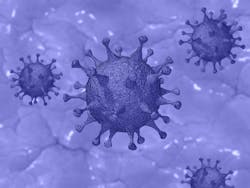Nanobodies disarm virus and block it from infecting cells with COVID-19
SARS-CoV-2 nanobodies — microscopic molecules developed at the University of Pittsburgh School of Medicine that neutralize the virus in animals — are remarkably active against mutations found in variants, including Delta, according to new research by Pitt and Case Western Reserve University scientists.
The findings, announced in Nature Communications, describe three different mechanisms by which the nanobodies disarm the virus, blocking it from infecting cells and causing COVID-19. The near-atomic-level structural analysis provides guidance for the development of future vaccines and therapeutics that may work against a wide variety of coronaviruses — including variants not yet in circulation, according to a news release from UPMC.
“This is the first time anyone has systematically classified ultrapotent nanobodies based on their structure,” said senior author Yi Shi, PhD, Assistant Professor of Cell Biology at Pitt. “By doing this, we’ve not only provided details on the mechanisms our nanobodies use to defeat SARS-CoV-2, but also revealed directions for how to design future therapeutics.”
In this latest study, Pitt partnered with Case Western Reserve to use high-resolution cryoelectron microscopy to observe exactly how the nanobodies interact with the SARS-CoV-2 virus to stop it from infecting cells and discover how mutations found in variants may affect nanobody interactions.
The team members selected eight potent nanobodies for further examination. First, they confirmed through observations that several of the nanobodies work against Alpha (a variant associated with the U.K.), Delta (which is associated with India) and several other SARS-CoV-2 variants of concern.
They also classified the nanobodies into three main groups based on how they interact with the spike proteins, which are the protrusions that encircle the spherical coronavirus and act as “keys” that grant the virus entry to human cells:
· Class I outcompetes the part of the human cell that the spike protein binds to, preventing the virus from gaining entry to cells.
· Class II binds to a region on the spike protein that has persisted through several permutations of coronaviruses — including the original SARS-CoV-1. This means it may neutralize SARS-CoV-2 and its variants, but also other coronaviruses.
· Class III latches on to a specific region of the spike protein that larger antibodies cannot access. By binding to this area, the nanobody prevents the protein from folding in the way it needs to for entry into human cells.

